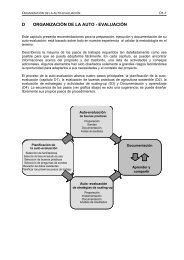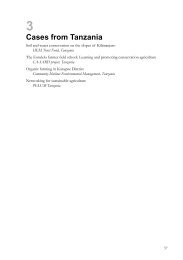Adaptation of small scale farmers to climatic risks in India - Sustainet
Adaptation of small scale farmers to climatic risks in India - Sustainet
Adaptation of small scale farmers to climatic risks in India - Sustainet
You also want an ePaper? Increase the reach of your titles
YUMPU automatically turns print PDFs into web optimized ePapers that Google loves.
NREGA <strong>in</strong> Rajasthan plays an important role and is one <strong>of</strong> the major sources <strong>of</strong> <strong>in</strong>come for many poor<br />
<strong>farmers</strong> and land less laborers. Compared <strong>to</strong> other states <strong>in</strong> <strong>India</strong>, NREGA <strong>in</strong> Rajasthan is particularly<br />
active. The relative importance <strong>of</strong> NREGA <strong>in</strong> Rajasthan compared <strong>to</strong> the <strong>India</strong>n average is shown <strong>in</strong><br />
Table 2.<br />
Migration: NREGA has the advantage <strong>of</strong> provid<strong>in</strong>g work close <strong>to</strong> the villages, but not all <strong>farmers</strong> f<strong>in</strong>d<br />
work through the government schemes. One direct impact <strong>of</strong> decl<strong>in</strong><strong>in</strong>g agricultural production is the<br />
<strong>in</strong>crease <strong>in</strong> migration rates. Dur<strong>in</strong>g the survey, it became clear that a substantial percentage <strong>of</strong> the<br />
village population is migrat<strong>in</strong>g every year <strong>to</strong> Jaipur or even <strong>to</strong> other states <strong>in</strong> order <strong>to</strong> f<strong>in</strong>d work and<br />
supplement their <strong>in</strong>come. Around 70% <strong>of</strong> the household <strong>in</strong> the study area have at least one person<br />
migrat<strong>in</strong>g every year. However, the ratio <strong>of</strong> people migrat<strong>in</strong>g varied strongly from village <strong>to</strong> village and<br />
is depend<strong>in</strong>g on the year <strong>in</strong> question as well. A study exam<strong>in</strong><strong>in</strong>g migration rates <strong>in</strong> Rajasthan dur<strong>in</strong>g<br />
drought periods reports important changes <strong>in</strong> occupation patterns. A severe drought <strong>in</strong> 2002-03 forced<br />
80% <strong>of</strong> the <strong>farmers</strong> <strong>to</strong> quit the fields and jo<strong>in</strong> the labor force, both at relief sites or <strong>in</strong> the regular<br />
economy (Rathore, 2004).<br />
2.4 <strong>Adaptation</strong> strategies <strong>of</strong> <strong>small</strong>-<strong>scale</strong> <strong>farmers</strong><br />
A old folklore from the Marwar area <strong>of</strong> Rajasthan says: “A century is made up <strong>of</strong> seven years <strong>of</strong> fam<strong>in</strong>e,<br />
twenty-seven years <strong>of</strong> plenty, sixty-four years <strong>of</strong> semi-drought, and two years <strong>of</strong> extreme drought”<br />
(Aparna 2001). Small-<strong>scale</strong> <strong>farmers</strong> <strong>in</strong> Rajasthan have cont<strong>in</strong>uously adapted their farm<strong>in</strong>g practices <strong>to</strong><br />
climate variability <strong>in</strong>herent <strong>to</strong> their environment. The experience <strong>of</strong> centuries has taught the traditional<br />
farmer an “empirical art <strong>of</strong> practic<strong>in</strong>g agriculture”, <strong>in</strong> tune with nature’s vagrancies (Randhawa et al.<br />
1961). In this sense, traditional knowledge <strong>of</strong> Rajasthani <strong>farmers</strong> can prove extremely useful <strong>to</strong> address<br />
climate change challenges <strong>in</strong> Rajasthan or other areas. However, some local NGO specialists claim<br />
that <strong>farmers</strong> were better adapted <strong>to</strong> their environment a few decades ago than they are now. High <strong>in</strong>put<br />
agriculture <strong>in</strong>troduced <strong>in</strong> the area <strong>in</strong> the name <strong>of</strong> technological progress made <strong>farmers</strong> more vulnerable<br />
<strong>to</strong> climate hazards, rather than improv<strong>in</strong>g their livelihoods.<br />
Nevertheless, this traditional knowledge still exists <strong>in</strong> the villages and some practices could prove very<br />
useful as adaptation measures <strong>to</strong> new climate change threats. They are described <strong>in</strong> the follow<strong>in</strong>g<br />
section.<br />
2.4.1 Agriculture sec<strong>to</strong>r<br />
Susta<strong>in</strong>able soil and crop management: Instead <strong>of</strong> rely<strong>in</strong>g on high <strong>in</strong>put agriculture by us<strong>in</strong>g hybrid<br />
seeds, chemical fertilizers and pesticides, some <strong>farmers</strong> still trust on the force <strong>of</strong> traditional soil and<br />
crop management practices. Such practices consider the highly variable environment and the fragile<br />
ecosystem <strong>in</strong> a far better way than agricultural activity, solely aim<strong>in</strong>g at maximiz<strong>in</strong>g outputs. Such<br />
susta<strong>in</strong>able practices <strong>in</strong>clude among others:<br />
26<br />
26




